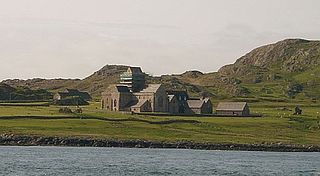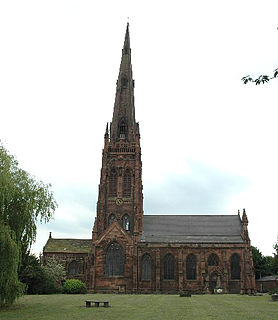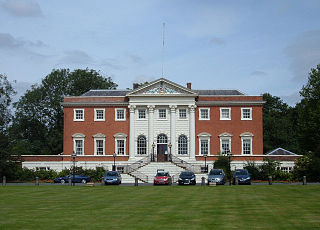
Ashton-in-Makerfield is a town in Greater Manchester, England. It is part of the Metropolitan Borough of Wigan and is 4.2 miles (6.8 km) south of the town of Wigan. In 2001 it had a population of 28,505, increasing to 28,762 at the 2011 Census.

Bardney is a village and civil parish in the West Lindsey district of Lincolnshire, England. The population of the civil parish was 1,643 at the 2001 census increasing to 1,848 at the 2011 census. The village sits on the east bank of the River Witham and 9 miles (14 km) east from the city and county town of Lincoln.

Birinus was the first Bishop of Dorchester and was known as the "Apostle to the West Saxons" for his conversion of the Kingdom of Wessex to Christianity. He is venerated as a saint by the Roman Catholic Church, the Eastern Orthodox Church, and Anglican churches.

Saint Edmund Arrowsmith, SJ, is one of the Forty Martyrs of England and Wales of the Roman Catholic Church. The main source of information on St Edmund is a contemporary account written by an eyewitness and published a short time after his death. This document, conforming to the ancient style of the "Acts of martyrs" includes the story of the execution of another 17th-century Recusant martyr, Richard Herst.

The Roman Catholic Archdiocese of Liverpool is an archdiocese of the Catholic Church that covers the Isle of Man and part of North West England. The episcopal see is Liverpool Metropolitan Cathedral. The Archdiocese is the centre of the Ecclesiastical Province of Liverpool which covers the north of England as well as the Isle of Man.

Oswald of Worcester was Archbishop of York from 972 to his death in 992. He was of Danish ancestry, but brought up by his uncle, Oda, who sent him to France to the abbey of Fleury to become a monk. After a number of years at Fleury, Oswald returned to England at the request of his uncle, who died before Oswald returned. With his uncle's death, Oswald needed a patron and turned to another kinsman, Oskytel, who had recently become Archbishop of York. His activity for Oskytel attracted the notice of Archbishop Dunstan who had Oswald consecrated as Bishop of Worcester in 961. In 972, Oswald was promoted to the see of York, although he continued to hold Worcester also.
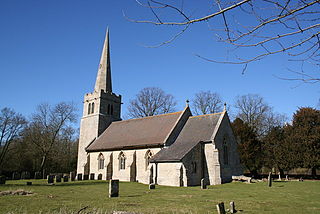
Saint Hybald, also known as Higbald, Hibald or Hygbald, was a 7th-century Saxon saint. His feastdays are 18 September and 14 December (Orthodox).
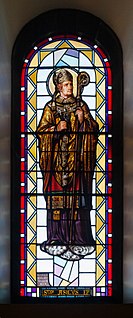
Saint Assicus(Asicus, Assic) was the first bishop of Elphin, Ireland, and venerated as the patron saint of that place. He was also an artisan metalworker.

St Oswald's Church, is in the village of Winwick, Cheshire, England. The church is recorded in the National Heritage List for England as a designated Grade I listed building. It is an active Anglican parish church in the diocese of Liverpool, the archdeaconry of Warrington and the deanery of Winwick.
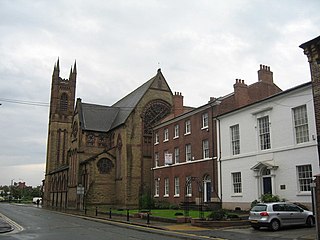
St Mary's Church, or St.Mary's Priory, is in the town centre of Warrington, Cheshire, England. It is recorded in the National Heritage List for England as a designated Grade II listed building, and is an active Roman Catholic church. The parish was established and served by Benedictine monks from Ampleforth Abbey, but following the withdrawal of Ampleforth Abbey from the parish in 2012, it was served by the priest from St Benedict's Church, Warrington. From November 2015, the church has been owned and served by priests from the Priestly Fraternity of Saint Peter (FSSP) as a shrine church dedicated to the celebration of the sacraments of the extraordinary form of the Roman Rite. It is well known for the beauty and reverence of its liturgy and the ambition and excellence of the church choir and music.
George Joseph Plunket Browne (1795–1858) was an Irish Roman Catholic clergyman. Born to a "well-known Roscommon family", he served as Bishop of Galway from 1831 until 1844, and afterward as Bishop of Elphin, until his death on 1 December 1858. He was charged with being a "Cullenite" in 1855, that is, a follower of ultamontane Paul Cardinal Cullen.

Charles Dodgson was an Anglican cleric, scholar and author. He was the father of Charles Lutwidge Dodgson, better known as Lewis Carroll.

St Thomas' Church is in Warrington Road, Ashton-in-Makerfield, Greater Manchester, England. It is an active Anglican parish church in the deanery of Wigan, the archdeaconry of Warrington, and the diocese of Liverpool. Its benefice is united with that of St Luke, Stubshaw Cross. The church is recorded in the National Heritage List for England as a designated Grade II listed building.
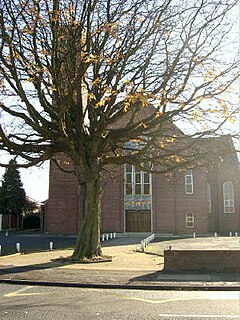
St Oswald's Church is an active Roman Catholic church in the Padgate suburb of Warrington, Cheshire, England. The parish was founded by Benedictine monks from Ampleforth Abbey, it is now served by clergy from the Roman Catholic Archdiocese of Liverpool.
There are over 9,000 Grade I listed buildings and 20,000 Grade II* listed buildings in England. This page is a list of these buildings in the unitary authority of Warrington in Cheshire.

William Owen was an English architect who practised in Warrington, which was at that time in Lancashire, England. His works were confined to Northwest England. Owen is best known for his collaboration with William Lever in the creation of the soap-making factory and associated model village at Port Sunlight in the Wirral Peninsula. Here he designed the factory, many of the workers' houses, public buildings and the church. Later Owen was joined by his son, Segar, as a partner. On his own, or in partnership, Owen designed houses, churches, banks, public houses, an infirmary, a school, and a concert hall.

St Benedict's Church is an active Roman Catholic church in the Orford suburb of Warrington, Cheshire, England. The parish was founded by Benedictine monks from Ampleforth Abbey. However, it is now served by clergy from the Roman Catholic Archdiocese of Liverpool.
Ashton-in-Makerfield is a town in the Metropolitan Borough of Wigan, Greater Manchester, England. It contains ten listed buildings that are recorded in the National Heritage List for England. All the listed buildings are designated at Grade II, the lowest of the three grades, which is applied to "buildings of national importance and special interest". Industry, including coal mining, came to the town in the 19th century, but it is now mainly residential. The older listed buildings consist of farmhouses, a farm building, a chapel and a milestone, and the later ones are churches and associated structures, and a library.




